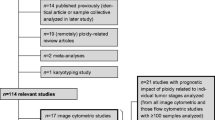Abstract
In 68 patients the DNA content of tumor cells was measured by image cytometry after resection of the rectum because of cancer. In the DNA histogram a differentiation between diploid (n=19), polyploid (n=24), hypotriploid (n=17), and hypertriploid (n=8) tumors was possible. The best relapse-free survival time was found in patients with diploid tumors. The prognosis worsened from polyploid to hypotriploid and was worse in hypertriploid tumors. Testing for a prognostic advantage of diploid over aneuploid tumors without adjustment for additional factors simply by means of the log-rank statistic gave a (one-sided) P of 0.1013. In a multivariate analysis the degree of differentiation turned out most important. Again, an appropriate test for prognostic relevance of DNA content failed to be significant (P =0.3264).
Similar content being viewed by others
References
Wiggers T, Arends JW, Schutte B, Volovics L, Bosman FT. A multivariate analysis of pathologic prognostic indicators in large bowel cancer. Cancer 1988;61:386–95.
Scott NA, Rainwater ZM, Wieand HS, et al. The relative prognostic value of slow cytometric DNA analysis and conventional clinicopathologic criteria in patients with operable rectum carcinoma. Dis Colon Rectum 1987;30:513–20.
Armitage NC, Robins RA, Evans DF, Turner DR, Baldwin RW, Hardcastle ID. The influence of tumor cell DNA abnormalities on survival in colorectal cancer. Br J Surg 1985;72:828–30.
Banner BG, Thomas De La Vega JE, Roseman DL, Coon JS. Should flow cytometric DNA analysis precede definitive surgery for colon carcinoma? Ann Surg 1985;202:740–4.
Böttger T, Störckel S, Stöckle M, et al. DNA image cytometry—a prognostic tool in esophagus cancer. Cancer 1991;67:2290–4.
Böttger T, Störckel S, Stöckle M, Gerber B, Vinh T, Junginger T. Bildanalytische DNS-Zytometrie zur Beurteilung der Prognose bei duktalen Pankreaskarzinomen. Chirurg 1991;62:725–31.
Emdin SD, Stenling R, Roos G. Prognostic value of DNA content in colorectal carcinoma. Cancer 1987;60:1282–7.
Enblad P, Glimelius B, Bengtsson A, Ponten J, Pahlman L. The prognostic significance of DNA content in carcinoma of the rectum and rectosigmoid. Acta Chir Scand 1987;153:453–8.
Finan PJ, Quirke P, Dixon MF, Dyson JE, Giles GR, Bird CC. Is DNA aneuploidy a good prognostic indicator in patients with advanced colorectal cancer? Br J Cancer 1986;54:327–30.
Forsslund G, Cedermark B, Öhman U, Erhardt K, Zetterberg A, Auer G. The significance of DNA distribution pattern in rectal carcinoma. Dis Colon Rectum 1984;27:579–84.
Frankfurt OS, Arbruck SG, Greco WR. Prognostic significance of DNA ploidy in human colo-rectal cancer. Pro ASCO 1984;3:17.
Hiddemann W, Bassewitz DB, Kleinemeier HJ, et al. DNA stemline heterogeneity in colorectal cancer. Cancer 1986;58:258–63.
Kokal WA, Duda RB, Azumi N, et al. Tumor DNA content in primary and metastatic colorectal carcinoma. Arch Surg 1986;121:1434–8.
Melamed MR, Enker WE, Banner P, Janov AJ, Kessler G, Darzynkiewicz Z. Flow cytometry of colorectal carcinoma with three-year follow-up. Dis Colon Rectum 1986;29:184–6.
Peterson SE, Bickel P, Lorentzen M. Flow-cytometric demonstration of tumorcell subpopulations with different DNA content in human colorectal carcinoma. Eur J Cancer 1978;45:383.
Quirke P, Dyson JE, Dixon ME, Bird CC, Joslin CA. Heterogeneity of colorectal adenocarcinomas evaluated by flow cytometry and histopathology. Br J Cancer 1985;51:99–106.
Rübe C, Valet G, Eder M. Cellular DNA content and metastasis pattern in colorectal carcinoma. Virchows Archiv A Pathol Anat Hist 1988;413:419–24.
Schillaci A, Tirindelli D, Ferri M, et al. Flow cytometric analysis in colorectal carcinoma. Int J Colorectal Dis 1990;5:223–7.
Hermanek P, Gall FP. Early (microinvasive) colorectal carcinoma. Pathology diagnosis surgical treatment. Int J Colorectal Dis 1986;79:84.
Stöckle M, Tancke HJ, Voges G, Riedmiller H, Hohenfellner R. DNA histogram of invasive bladder carcinoma: comparison of flow cytometry and automated image analysis. In: Rubben H, Jacobi R, Jochan GH, eds. Investigative urology. 3rd ed. New York: Springer Verlag, 1989:104–14.
Kokal W, Sheibani K, Terz J, Harada JR. Tumor DNA content in the prognosis of colorectal carcinoma. JAMA 1986;255:3123–7.
Scott NA, Grande JP, Weiland LH, Pemberton JH, Beart RW Jr Lieber MM. Flow cytometric DNA pattern from colorectal cancer—how reproducible are they. Mayo Clin Proc 1987;62:331–7.
Spremulli EN, Scott C, Campell DE, et al. Characterization of two metastatic subpopulations originating from a single human colon carcinoma. Cancer Res 1983;43:3825–35.
Streffer C, Van Benningen D, Gross E, Schabronath J, Eigler FN, Rebmann A. Predictive assays for the therapy of rectum carcinoma. Radiother Oncol 1986;5:303–10.
Tanke HJ, van Ingen EM, Ploem JS. Acriflavin-Feulgen stilben staining: a procedure for automated cervical autology with a television based system (Leytas) J Histochem Cytochem 1974;27:84–6.
Driel-Kulker AM, Mesker WE, Velzen JV, Tanke HJ, Feichtinger J, Ploem JS. Preparation of monolayer smears from paraffin embedded tissue for image cytometry. Cytometry 1985;6:268.
Meyer F. Iterative image transformation for automative screening of cervical smears. J Histochem Cytochem 1979;27:128.
Freedman LS. Tables of the number of patients required in clinical trials using the logrank test. Stat Med 1982;1:121–9.
Cox DR. Regression models and life tables (with discussion). J R Stat Soc B 1972;34:187–220.
Kalbfleisch JD, Prentice RC, eds. The statistical analysis of failure time data. New York: Wiley and Sons, 1980:249.
Scott NA, Wieand HS, Moertel CG, Cha SS, Beart RW Jr, Lieber MM. Colorectal cancer. Duke's stage, tumor site, preoperative plasma CEA level, and patient prognosis related to tumor DNA ploidy pattern. Arch Surg 1987;122:1375–9.
Wolley RL, Schreiber K, Koss LG, Karas M, Sherman A. DNA distribution in human colon carcinomas and its relationship to clinical behavior. INC 1982;69:15–22.
Kokal WA, Gardine RL, Sheibani K, et al. Tumor DNA content in resectable, primary colorectal carcinoma. Ann Surg 1989;209:188–93.
Author information
Authors and Affiliations
About this article
Cite this article
Böttger, T.C., Gabbert, H.E., Stöckle, M. et al. DNA image cytometry: A prognostic tool in rectal cancer?. Dis Colon Rectum 35, 436–443 (1992). https://doi.org/10.1007/BF02049399
Issue Date:
DOI: https://doi.org/10.1007/BF02049399




